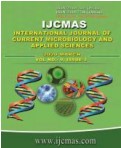


 National Academy of Agricultural Sciences (NAAS)
National Academy of Agricultural Sciences (NAAS)

|
PRINT ISSN : 2319-7692
Online ISSN : 2319-7706 Issues : 12 per year Publisher : Excellent Publishers Email : editorijcmas@gmail.com / submit@ijcmas.com Editor-in-chief: Dr.M.Prakash Index Copernicus ICV 2018: 95.39 NAAS RATING 2020: 5.38 |
The experiment was conducted at Jabalpur (M.P.) for 2 consecutive years (2007-08 to 2008-09) to identify suitable diversified cropping systems to study productivity, water economics, mining of nutrients and soil improvement over existing rice-wheat and rice-chickpea cropping system for Kymore Plateau and Satpura Hills agroclimatic zone. Between the 4 varieties of rice of different duration, Pro Agro 6444 topped in yield attributes like tillers/ m2 (434.6 to 434.9) and grains per panicles (155.7 to 156.7) along with grain (6.25 to 6.31 t/ha) and straw yields (9.38 to 9.44 t/ha). Among the 12 rice-based cropping systems tested, Hy. rice-vegetable pea-sunflower topped for rice equivalent yields and production efficiency (24.82 t/ha, 7.91 kg/ha/day), followed by Hy rice-garlic-maize+cowpea fodder (22.02 t/ha, 6.79 kg/ha/day) and Hy rice-potato-maize cob+fodder (19.02 t/ha.5.92 kg/ha/day) in chronological order. The consumptive use of water was found to be maximum (201.16 cm/ha) for Rice (Pusa Basmati-1) - Berseem (JB-5) fodder+Seed while water productivity was highest (582.87 kg/ha/cm) for Hy rice (JRH-5) – Vegatable pea (Arkel) -Sunflower (PSH-12). All newly proposed diversified intensive crop-sequences removed higher quantity of essential plant nutrient elements (N,P,K) than existing crop-sequences and ther did not show remarkable change in physic-chemical properties of the soil over their parental status, when existing rice-wheat system exhibited significant reduction in organic and N contents of soil.
 |
 |
 |
 |
 |